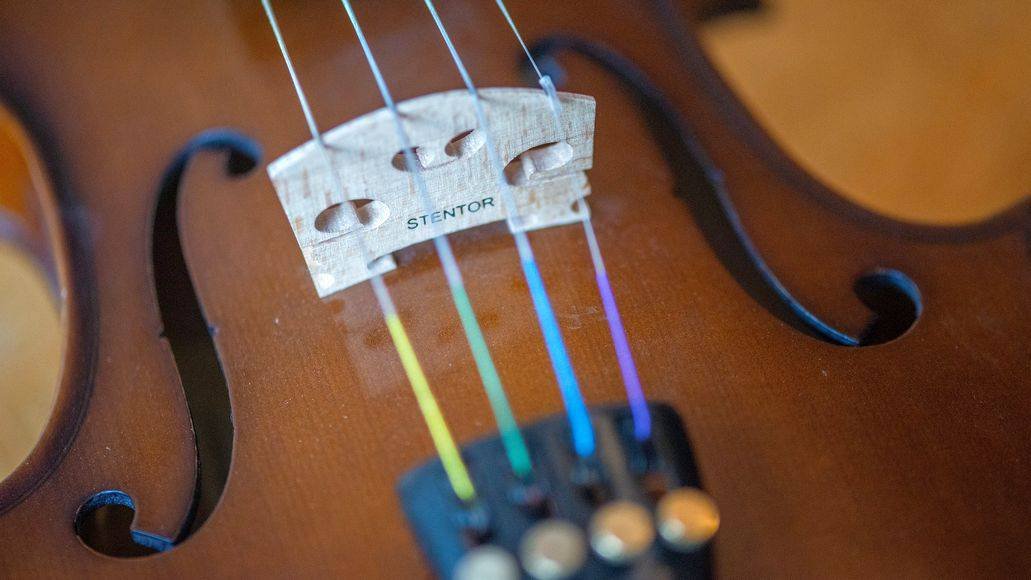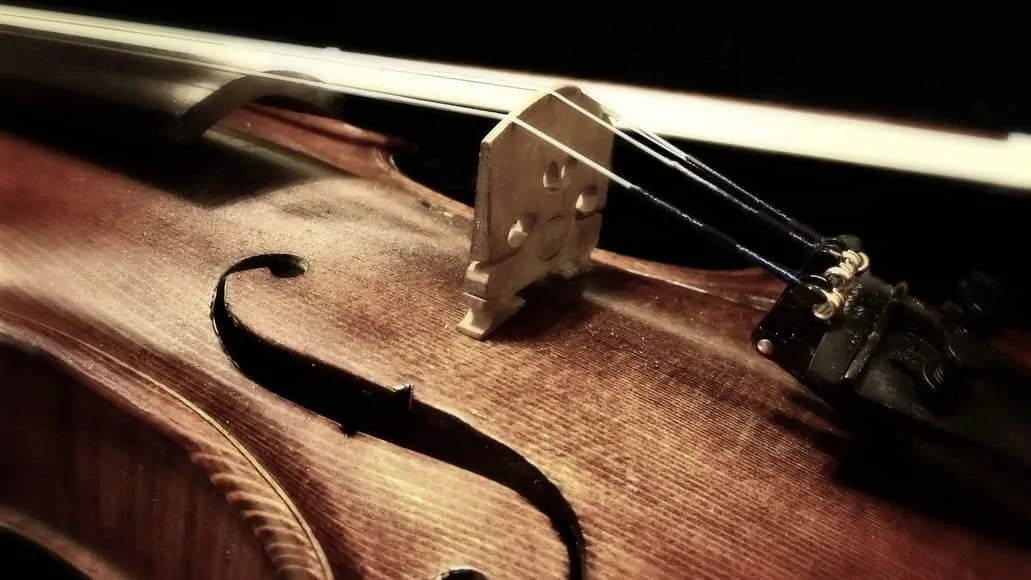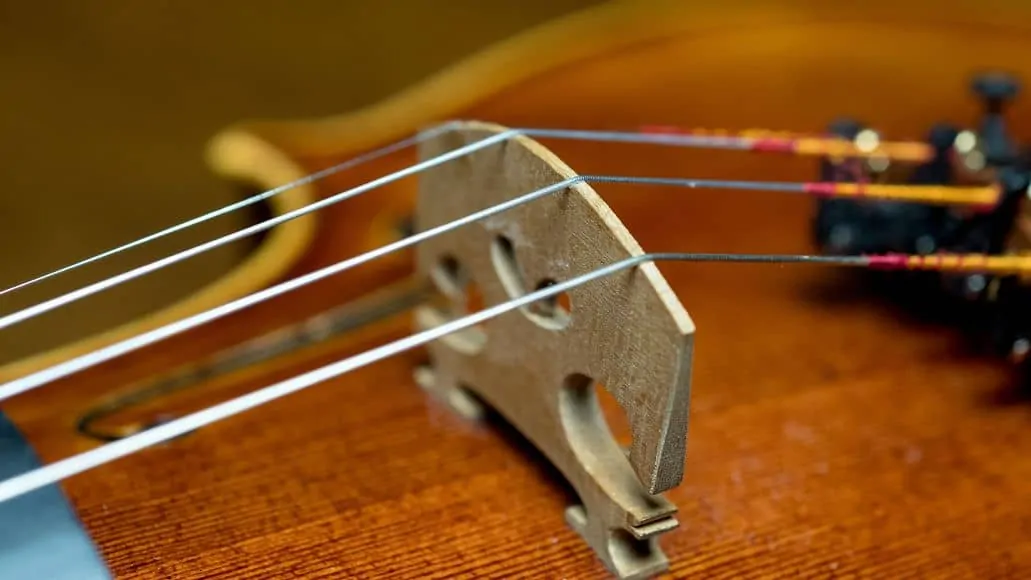 Violin strings are just as important as the violin itself.
Violin strings are just as important as the violin itself.
Changing strings does more for your sound than buying a better violin, when you consider the cost of replacement versus the benefit.
But we don’t just change strings when we want to achieve a different sound.
You also need to swap out the strings when they begin to deteriorate and negatively affect the sound.
Depending on the strings you use, this can happen quite quickly. You may find that you need to change your strings every few months, or perhaps even more frequently.
Keep reading to learn how long violin strings generally last. It differs considerably from one type of string to another.
Table of Contents
How Long Do Violin Strings Last?
How long a violin string lasts depends on the string type, quality, and the amount of use. What are violin strings made of and how long does each material last on average? With regular everyday use:
- Synthetic strings last around 6 months
- Metal ones last around 10 months
- Gut strings last around 3 months
Broken or loosely wound strings must be replaced. The same is true if they are very old, because the older they are, the duller your instrument will sound.
All that said, it is difficult to determine exactly how long a set of strings lasts. It depends on many factors: how many hours you play them, how clean you are, the type of sweat on your hands, etc.
If they are synthetic and you play a few hours a week, you can change them every 6 months. If you notice a big difference in the way they play and sound, change them sooner.

If you don’t notice a difference, you can wait longer for the next change. The duration also depends on how clean you keep them, the hygiene of your hands, the type of sweat, the way of playing, and more.
Metallic strings usually last a little longer than synthetic ones. Gut strings have the shortest life. Some wounds are more easily damaged by sweat than others, such as aluminum.
If you are not going to play in public for a long time and you only use the violin to practice, you can try to keep the strings longer.
When To Change The Strings
Strings should not be changed only when they break or visibly deteriorate (worn or loose winding). When you use them for a long time, they often begin to lose pitch or sound dull.
The better you play, the better the violin sounds. And the more experience you have, the sooner you will realize when the strings need to be replaced.
New strings usually sound brighter. Some violinists change the E string very often because they like that sound in high tones.
If a string in a set breaks, the new string will probably sound louder than the others. Some like this on the E string, which they change very often to make it sound bright.
You can have used strings as a spare for broken strings. This can save you some money.
Gut strings need special tensioners because the normal ones would break right away. They should also have special protectors, at least on the E string.
Why Change Strings Before Breaking?

Choosing the right strings for your violin is a very important factor in the quality of the sound you get. By comparison, buying good violin strings is a much more profitable investment than changing violins, relative to the sound improvement it provides.
Try to get the most suitable and best possible strings. Even if the instrument does not do them justice, you will still get the best sound your violin is capable of giving.
The strings always maintain a perfect fifth with the one next to them, no matter how high up we pluck them. But if there are old strings next to new ones, this may not be exactly true in high positions (although this could also happen due to a poorly placed bridge).
Strings last longer if you keep them clean and protected. So don’t be lazy and always clean them when you finish playing.
What Type Of Strings To Choose
There are no universal strings for everyone. The point is to find strings that complement the quality of your instrument and playing style.
Each type of string has its own specific characteristics that can change the sound of your instrument. These characteristics can result in subtle changes in sound quality, playing convenience, instrument response.
On the other hand, each instrument also has its own specific characteristics and therefore can react better or worse to certain types of strings. All in all, strings that respond well to one instrument may not make a good sound on another.
There are also an immense number of playing styles that dictate the choice of strings. A classical violinist can choose strings that are completely inappropriate for a folk musician. The jazz bassist will choose strings that will make it difficult for the symphonic bassist to play.
Intestinal/Gut Strings
Many classical musicians still prefer intestinal strings, because of their warm sound, complexity, and rich mid-tones. When you play gut strings, you can hear much more than just a simple tone.
Musicians who perform early music on baroque-style instruments use only intestinal strings.
Of course, there are some problems with intestinal strings, such as their instability. They need frequent tuning, especially in the first week after installation, due to their stretching.
They are also very sensitive to changes in temperature and humidity. Furthermore, they are more expensive than most other strings. Due to all these characteristics, we don’t recommend them for beginners, or any students, really.
Steel Strings

Steel strings have a very stable tone immediately after installation. They have a sound completely different from intestinal strings, with a tendency towards a pure, crystalline, simple sound. It is usually a little harder, with only a few mid-tones and without complexity.
Non-classical musicians, especially folk violinists, and also by many jazz musicians, often use steel strings. These strings also work well with smaller, cheaper student instruments. Furthermore, most bassists use steel strings.
There are also very interesting changes in the construction of steel strings that arouse special interest among cellists.
The steel core (usually thin fibers of longitudinal or spiral steel) is now coated with various metals such as aluminum, chrome steel, tungsten, silver, and most often titanium. These changes in technology allow manufacturers to produce strings with a more sophisticated sound.
Synthetic Strings
Over the past 30 years, more and more musicians have been switching from intestinal to synthetic strings. Most of these strings use one type of nylon for the core.
These strings have many tonal characteristics of intestinal strings, but with a much more stable tone, and they generally have a better reaction. There is a much smaller need for tuning and they are “played” in a day or two after installation, unlike the usual week needed to stabilize intestinal strings.
Since their core is synthetic, these strings should be more stable in quality than intestinal ones, but they have some shortcomings in the complexity of sound.
Because of this, some musicians still prefer intestinal strings. There are a large number of different synthetic strings on the market today, each with their own specific characteristics.
How Long Violin Strings Last: Final Thoughts
The biggest factor that determines the usable lifespan of a violin string is the type of material from which it is made. But even two identical strings can last for very different lengths of time.
That’s because so many other factors come into play. How often you play on the strings obviously matters, as does your style of playing, the cleanliness of your fingers, the amount of rosin you use, the climate in your area, and so much more.
In the end, you’ll know when you need new strings based on how it feels to play the current ones and how they sound. Once those things deteriorate too much, you’ll want to replace the strings.
Leave a Reply